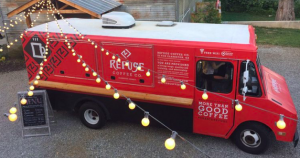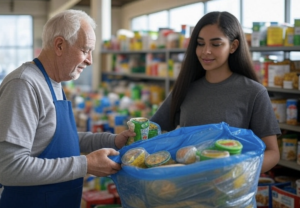As the co-founder of M&R Specialty Trailers and Trucks, I’ve had the privilege of watching the food truck industry evolve over the past 20+ years. While we often focus on business metrics and customer engagement, there’s an inspiring side to this industry that deserves recognition. Today, I wanted to take a step back and look at some of the ways food trucks are being used as catalysts for positive change in their communities. Whether it’s outfitting trucks to help with disaster relief, utilizing mobility to reach and serve those experiencing homelessness, or donating extra time and profits to charity, the service provided by these food trucks can be described as nothing less than amazing.
M&R Customers Making a Difference
At M&R, we’re proud that many of our customers are actively involved in charitable work. Some of these include BOBO’s Que in North Carolina, Theo’s Neighborhood Pizza Truck in New Orleans, and The Latin Soul Grille Food Truck in Jacksonville, FL. In an upcoming post, we plan to feature The Latin Soul Grille and their work helping a homeless shelter to distribute meals.
What makes these customers special isn’t just their commitment to quality food but their understanding that a food truck is a powerful platform for community engagement. When we build these trucks, we’re not just creating mobile kitchens – we’re crafting vehicles that will become fixtures in neighborhoods, at community events, and increasingly, at the frontlines of disaster relief and charitable outreach.
A Personal Connection: Building Refuge Coffee Co.’s Fleet
One of our most inspiring partnerships has been with Refuge Coffee Co., for whom we’ve built two trucks. I remember when founder Kitti Murray first approached us with her vision – not just for a coffee business, but for a vehicle of social transformation. She wanted trucks that could serve as both coffee shops and training centers for refugees resettled in the Atlanta area.
Building those first trucks for Refuge was different from our typical projects. We weren’t just configuring an espresso machine and storage – we were designing spaces where refugees would learn skills, gain confidence, and begin their American journey. Kitti’s vision required thoughtful design: extra counter space for training, multilingual signage, and equipment that could be operated by people still learning English.
Years later, seeing those same trucks still in operation – now staffed by confident baristas who arrived in America with nothing – remains one of the most rewarding aspects of our work at M&R. Refuge Coffee was founded on the simple idea that all humans are worthy of welcome. They use their coffee trucks not just to serve great beverages but as vehicles for social change, providing job training and employment opportunities for refugees. Their motto that “all of us can do the work of welcome” drives everything they do – from how they hire and educate to how they serve their community.

Built by M&R Specialty Trailers and Trucks.
Food Trucks Responding to 2025 Los Angeles Fires
The recent devastating wildfires in Los Angeles County have showcased how mobile food operators can quickly mobilize in times of crisis. When fires swept through neighborhoods in January 2025, food truck owners demonstrated remarkable generosity and quick response.
Yeastie Boys, a popular bagel truck operation, pivoted their entire business model in a moment of crisis. Rather than continuing with business as usual, owner Evan Fox redirected his seven food trucks to evacuation centers across Los Angeles, distributing more than 1,000 bagels to displaced residents and first responders. Fox noted that the decision was immediate and instinctive: “At 6 a.m. it was like, ‘Wait a minute,'” he said. “Immediately that was the [decision], and I just felt really good about it.” They partnered with World Central Kitchen, the humanitarian organization founded by chef José Andrés, to provide sustained relief.
What began as two hot dog carts offering 500 free hot dogs outside the Rose Bowl in Pasadena quickly transformed into a major community resource. Through the power of social media, particularly TikTok, word spread about food truck vendors gathering to help those affected by the Eaton Fire. Juan Diaz, one of the organizers, noted how rapidly things escalated: “It started with just two hotdog carts [Wednesday.] We planned to give out just 500 hotdogs.” The site evolved into a pop-up donation center where people could receive not only meals but also clothing, toiletries, and baby supplies.
For people like Carlos Linares, who lost his home in Altadena, this community support was invaluable. “Our house did burn down in Altadena, so we don’t really have anything – so just trying to get anything we can,” he said. “It means the world to me. This is my community, and I’m so grateful to have them.”
Restaurants and Food Trucks Unite for Disaster Relief
The Los Angeles fires also demonstrated how brick-and-mortar restaurants and food trucks can collaborate during crises. Vietnamese restaurant Bé Ù in Silver Lake posted signs offering free meals to evacuees and first responders. Owner Uyên Lê emphasized that her business has always been about “community, resilience and support,” adding, “I also think it’s important to show leadership at a time like this, and hopefully, other folks who have the capacity to attend [to] areas where they feel safe can also continue to provide resources and support for our community members.”

Doing charity work in the community.
Similarly, food truck operation Heavy Handed offered free meals for fire, police, and first responders while also making themselves available to deliver food to groups in need. Other mobile vendors like Villa’s Tacos joined the effort, with owner Victor Villa sharing that he and his team were making “as many Villa’s Trios as possible to pass out to our firefighters and first responders.”
This collaborative spirit extended to major culinary figures as well. Celebrity chefs including Evan Funke of Mother Wolf, Susan Feniger and Mary Sue Milliken of Socalo and Border Grill, and Roy Choi joined forces with World Central Kitchen to provide coordinated relief efforts. In a video posted to Instagram, José Andrés could be seen setting up operations along PCH, saying, “We are setting up here the World Central Kitchen truck. We feed them from here: sandwiches, fruit, water.”
Food Banks Adopting the Food Truck Model
As housing costs have outpaced wage growth nationwide, food banks have seen increased demand from families and older adults. According to the U.S. Department of Agriculture, 13.5% of American households were food-insecure in 2023, and food bank leaders report that the situation has worsened since then.
Traditional food banks are increasingly adopting mobile strategies learned from the food truck movement. The Hunger Task Force in Milwaukee has developed a mobile pantry making 35 stops on a truck route designed to bring food directly to where people live, including specially selected Halal offerings for the city’s Muslim community. CEO Matt King emphasized that “it comes down to being responsive and listening to the needs of the people we serve, and then being willing to adapt.”

CHiPS in Brooklyn expanded its operations to include a food pantry truck that visits five Brooklyn neighborhoods, including stops at two elementary schools. This mobile approach has helped them dramatically increase their outreach – from serving 100-150 sit-down lunches daily before the pandemic to now providing 400-500 to-go meals each day. “There’s just been an explosion of need,” noted 75-year-old volunteer Mark Hoglund.
In Las Vegas, which has some of the highest unemployment in the country, the Obodo Collective operates a half-acre farm growing more than 20 different vegetables and fruits. Executive Director Tameka Henry explained their dignified approach: “They may be in need, but that doesn’t mean they should have to take whatever you give. I want them to have that dignity.”
The Future of Food Trucks for Good
Having worked with food truck entrepreneurs for over two decades, I’ve noticed a significant shift in the industry. While early adopters were primarily focused on building profitable businesses, today’s food truck owners often launch with dual missions: commercial success and community impact.
At M&R, we’re now regularly approached by non-profits, community organizations, and socially-minded entrepreneurs looking to build specialized trucks. We’ve designed trucks specifically for job training programs, mobile health clinics that offer nutrition education alongside meals, and disaster-response vehicles that can operate in areas without power or water hookups.
How You Can Support These Efforts
If you’re a food truck owner looking to give back, consider:
- Partnering with local evacuation centers during emergencies
- Donating a percentage of your profits to community organizations
- Offering job training programs for underserved populations
- Collaborating with food banks to reach underserved areas
- Participating in community fundraising events
- Developing specialized menus that address food insecurity with dignity
- Creating employment opportunities for populations facing barriers to employment
As we build food trucks at M&R, we’re inspired daily by how our customers use their mobile kitchens not just as businesses but as vehicles for social change. The food truck revolution has always been about more than just great street food, it’s about the unique ability of mobile businesses to meet people where they are and respond rapidly to community needs.
In a world where division often dominates headlines, the food truck community consistently demonstrates how small businesses can spark hope, foster connection, and provide essential services during life’s most challenging moments. We’re proud to play a small part in building the vehicles that make this important work possible.
